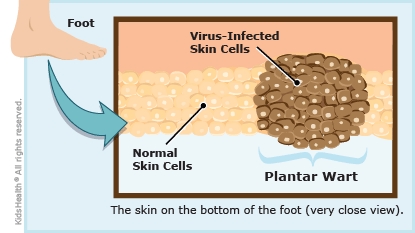Plantar Warts: How to Care for Your Child
Plantar warts are harmless skin growths on the bottom of the feet. Treatments are available, but most plantar warts will go away on their own.


Plantar warts are the result of a skin infection with a virus (a type of germ) called human papillomavirus (HPV). There are many types of HPV and they involve different parts of the body.
Plantar warts appear on the sole of the foot as thick or hard patches that can be bumpy or flat, often with tiny black spots or specks inside them. Plantar warts are sometimes painful and can feel like walking on a small stone.
Although plantar warts can happen at any age, they are most common in children and young adults.
Most plantar warts get better without treatment but it can take up to 2 years. To help the wart go away faster, to prevent spread, or if the wart is painful, the health care provider might suggest treatment. Your child's health care provider may prescribe a wart medicine to apply at home. In some cases, the health care provider might use a stronger medicine in the office to remove a wart. It can take several months for the wart to go away with treatment. Treated or not, plantar warts sometimes come back.

-
Do not try to remove the wart yourself by cutting, burning, picking, or any other method.
-
If a wart medicine was recommended for use at home, follow the health care provider's instructions for applying it. Before using the medicine:
-
Soak the wart in warm water for 10–20 minutes.
-
Remove dead skin on the wart's surface by filing with a new emery board or pumice stone. (To avoid spreading the wart, do not use the emery board or pumice stone on any other areas of the skin or nails.)
-
Wash hands after touching the wart.
-
If the wart is painful, apply a corn pad (a small cushion with a hole in it, available at most pharmacies) to help relieve pressure when your child is standing.
-
To prevent spreading warts to another part of your child's body or to another person:
-
Your child should wash the feet every day and dry them well.
-
Your child should change socks and shoes at least once a day.
-
Wash socks, washcloths, and towels that come into contact with the wart in hot water.
-
Make sure your child knows not to rub, scratch, or pick at the wart.
-
Your child should wear waterproof sandals or flip-flops in showers and locker rooms, and around public pools.


-
There is pain, redness, or swelling around the wart.
-
The wart bleeds or oozes pus.
-
The wart seems to be spreading.
-
You child won't stand or walk.
-
Your child limps.